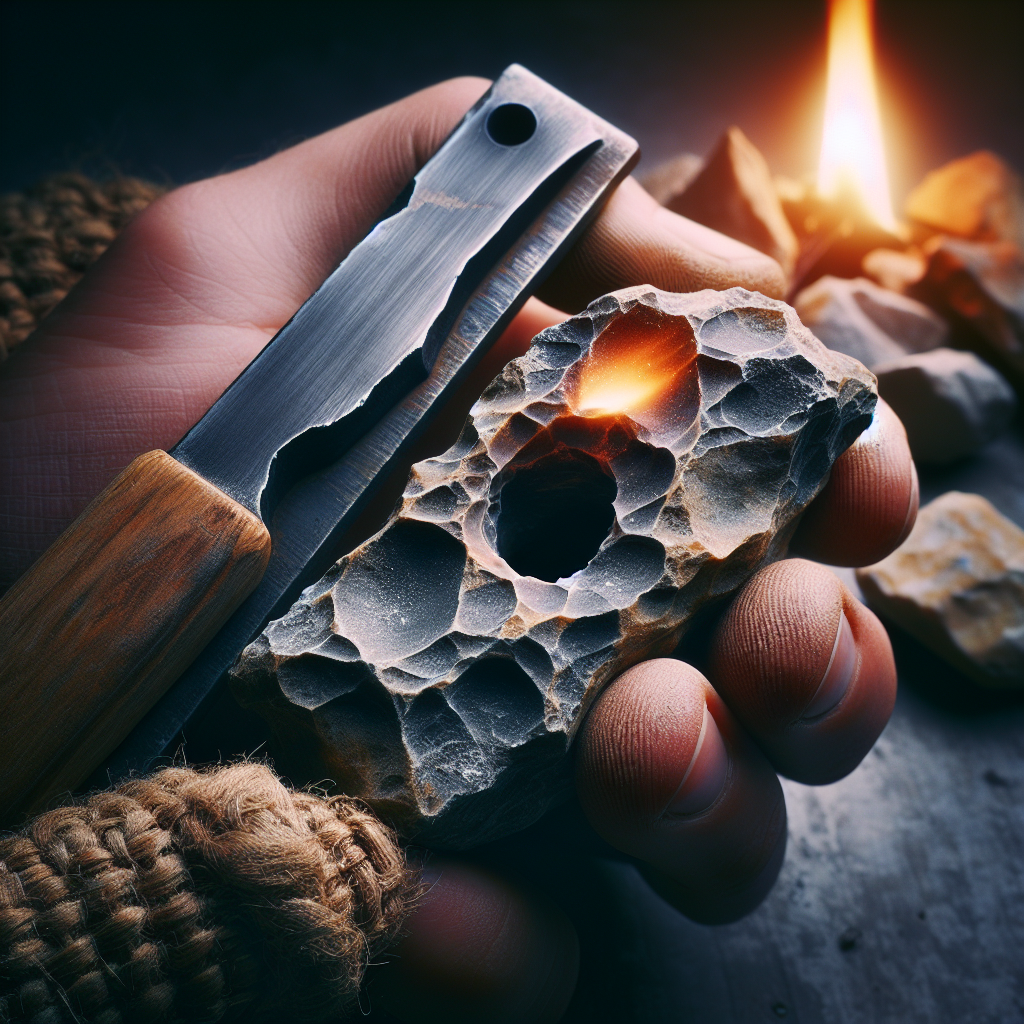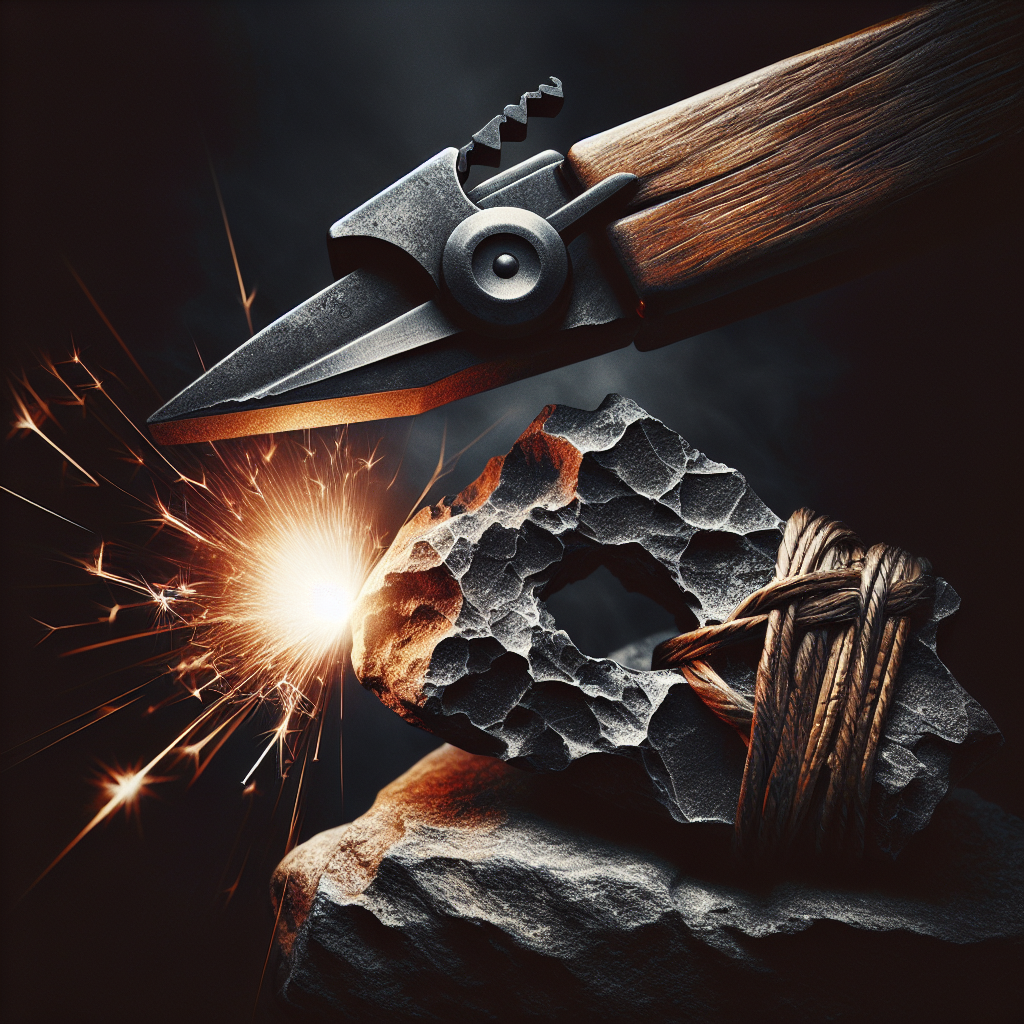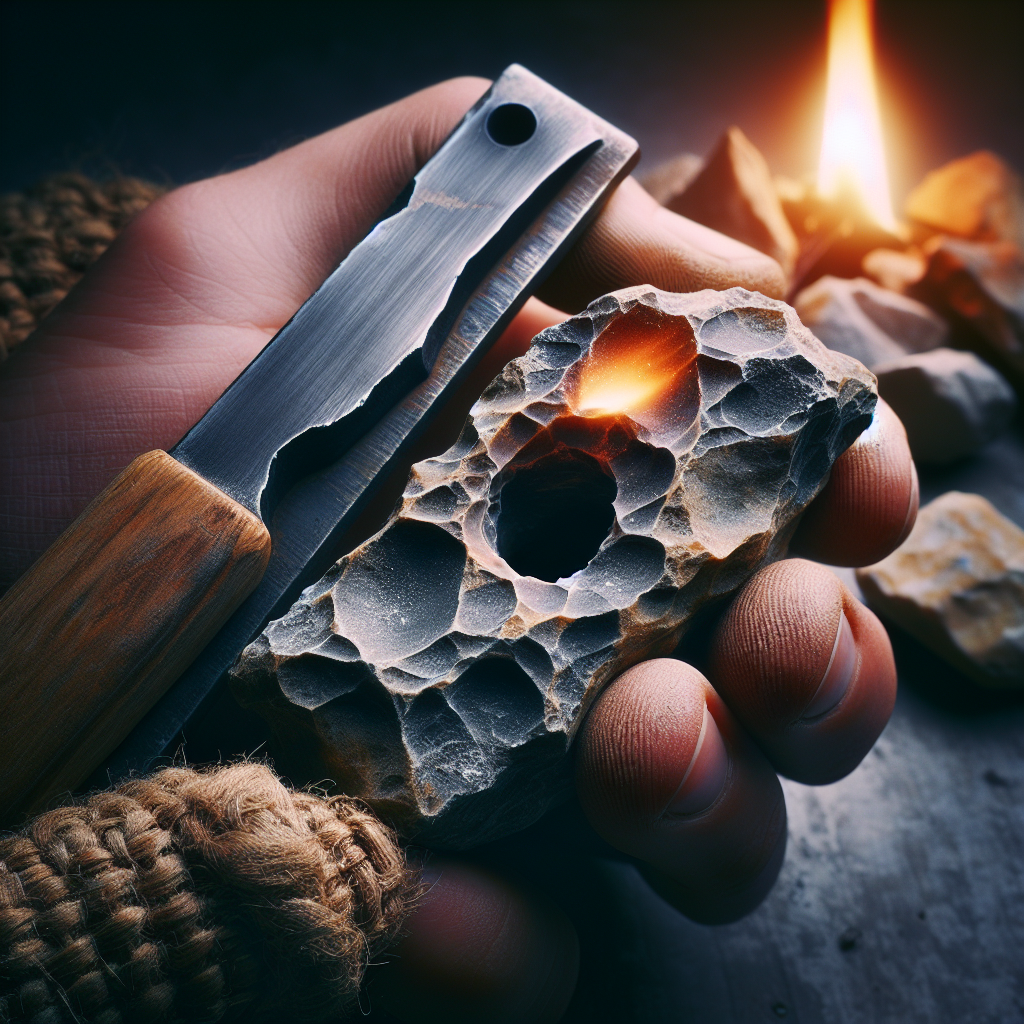Imagine being stranded in the wilderness with no matches or lighters to start a fire. Don’t panic! In this article, you will learn an easy and practical guide on how to make a flint and steel fire starter. By utilizing basic materials and following simple steps, you will soon have a reliable tool to start fires even in the harshest of conditions. With this knowledge, you’ll be better equipped to tackle the great outdoors and ensure your survival in any situation. So let’s get started on this exciting DIY project!
Materials Needed
To make a flint and steel fire starter, you will need a few essential materials. These include:
Flint
Flint is a hard, sedimentary rock that is excellent for creating sparks when struck against steel. Look for a piece that is smooth and free from cracks or impurities.
Steel
Choose a piece of high carbon steel for the best results. You can use an old file, a hacksaw blade, or even a specific fire striker designed for this purpose.
Char Cloth
Char cloth is a specially prepared fabric that catches and holds a spark, making it an ideal tinder material. You can make char cloth from pieces of 100% cotton fabric.
Tinder
Tinder is the combustible material that will catch fire when a spark lands on it. It should be dry, easily ignitable, and abundant in your surroundings. Examples of suitable tinder include dry leaves, bark, and wood shavings.
Container
A small container, such as a metal tin or a waterproof match case, is necessary for storing the flint, steel, and char cloth to keep them dry and protected.
Preparing the Flint
Preparing the flint is an essential step to ensure it produces sparks effectively. Follow these steps to prepare the flint:
Selecting the Flint
Look for a piece of flint that is roughly the size of your palm. It should be smooth and have no cracks, as these can hinder its effectiveness.
Removing Unwanted Portion
Inspect the flint and remove any unwanted portions by striking it against a hard surface. This will expose fresh, clean edges that are ideal for creating sparks.
Shaping the Flint
Carefully shape the flint into a manageable size and form. It should fit comfortably in your hand and have a pointed edge for striking against the steel.

Preparing the Steel
Preparing the steel is just as important as preparing the flint. Here’s how you can do it:
Choosing the Right Steel
Select a piece of high carbon steel that will generate a shower of sparks when struck against the flint. You can repurpose an old file, a hacksaw blade, or purchase a specialized fire striker.
Shaping the Steel
Shape the steel by grinding one edge to create a sharp, beveled edge. This is the part that will strike against the flint to create sparks. Ensure it is securely fastened to a handle for easy use.
Making Char Cloth
Char cloth is an integral part of your flint and steel fire starter kit. Here’s how you can make your own char cloth:
Choosing the Fabric
Start by selecting 100% cotton fabric. Old t-shirts or denim work well for this purpose. Avoid synthetic materials, as they will not create the desired charred effect.
Cutting and Preparing the Fabric
Cut the fabric into small squares, around 2×2 inches. Place the fabric squares into a metal tin, ensuring they fit snugly without being tightly packed.
Charring the Fabric
With the lid of the tin slightly ajar, place it on a heat-resistant surface, such as a campfire or a grill. Apply gentle heat until smoke starts to appear from the tin. After a few minutes, the smoke will subside, indicating that the fabric has turned into char cloth. Remove the tin from the heat and allow it to cool completely before opening.

Creating Tinder Bundle
A tinder bundle is crucial for catching the sparks and igniting a fire. Follow these steps to create a tinder bundle:
Collecting Suitable Tinder
Look for dry, easily ignitable materials in your surroundings. Dry leaves, grass, wood shavings, or small twigs make excellent tinder. Ensure they are well-dried and abundant.
Processing the Tinder
Gather a generous amount of the chosen tinder material and break it down into fine, fibrous pieces. Fluff them up to increase their surface area, making them more combustible and easily ignited.
Assembling the Firestarter
Now that you have prepared all the necessary components, it’s time to assemble your flint and steel fire starter. Follow these steps:
Placing the Flint and Steel Together
Hold the flint in your non-dominant hand, making sure the pointed edge is exposed. Take the steel in your dominant hand, holding it securely with your thumb and index finger.
Adding Char Cloth
Open your container and remove a piece of char cloth. Place it near the edge of the flint, allowing space for striking sparks to catch onto the cloth.
Storing in a Container
To keep your flint and steel fire starter kit protected and dry, store it in a small container, such as a metal tin or a waterproof match case. This ensures that all the components are readily available when needed.
Using the Flint and Steel Fire Starter
Now that you have your fire starter ready, it’s time to put it to use. Follow these steps to use the flint and steel fire starter effectively:
Finding the Right Fire Location
Choose an appropriate location for your fire, ensuring it is safe and well-ventilated. Avoid areas with low-hanging branches or dry vegetation that could easily catch fire.
Preparing the Fire Site
Clear the area of any flammable materials and make a small fire pit or fire ring. Gather additional firewood and arrange it nearby for easy access once the initial tinder ignites.
Striking Sparks and Igniting the Tinder
Hold the flint firmly and strike the steel against it with a swift, downward motion aimed at the pointed edge. The sharp edge of the steel should create sparks that land on the char cloth. Once the char cloth catches a spark, transfer it carefully onto your prepared tinder bundle, gently blowing on it to encourage combustion. As the tinder ignites, gradually add more fuel to build your fire.
Tips for Success
To increase your chances of success with your flint and steel fire starter, keep these tips in mind:
Be Patient
Flint and steel fire starting is a skill that requires patience. Take your time, strike the steel against the flint consistently, and provide enough sparks to ignite the char cloth and tinder bundle.
Use Proper Technique
Focus on striking the sharp edge of your steel against the flint at a shallow angle, allowing the sparks to fly towards the char cloth. Experiment with the speed and pressure until you find a technique that works best for you.
Practice beforehand
Before relying on your flint and steel fire starter in a survival situation, practice using it in a controlled environment. Familiarize yourself with the striking techniques and ensure you can consistently produce sparks and ignite the tinder.
Troubleshooting
If you encounter any issues while using your flint and steel fire starter, try these troubleshooting tips:
Flint and Steel Not Producing Sparks
Ensure that the flint and steel are firmly held together, creating proper contact. Adjust your striking technique, making sure the steel strikes the flint at an appropriate angle with enough force. Additionally, check that your flint and steel are in good condition, as worn or damaged surfaces may affect spark production.
Difficulty in Igniting the Tinder
If you’re struggling to ignite the tinder, check its dryness and fluffiness. Ensure it is as dry as possible and well-prepared, with fine fibers that catch sparks easily. Adjust the size and composition of the tinder bundle if necessary, providing more surface area for the sparks to catch.
Safety Precautions
When using a flint and steel fire starter, it’s crucial to prioritize safety. Follow these safety precautions:
Work in a Well-Ventilated Area
Ensure your fire site is well-ventilated to prevent the accumulation of smoke and harmful gases. Avoid starting fires indoors or in enclosed spaces.
Use Protective Gear
Wear appropriate protective gear, such as heat-resistant gloves or long sleeves, to prevent burns and injuries while operating the fire starter.
Keep Fire Extinguishing Tools Nearby
Have a ready supply of water, a fire extinguisher, or sand nearby to quickly extinguish any unintended fires. Never leave a fire unattended, and make sure it is completely extinguished before leaving the area.
By following these guidelines and practicing your flint and steel fire starting skills, you’ll have a reliable and efficient method for starting fires in various outdoor situations. Remember, safety is paramount, so prioritize it alongside your fire-making goals. Enjoy the warmth and comfort of a well-built fire while exploring the great outdoors!

